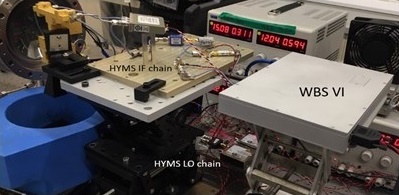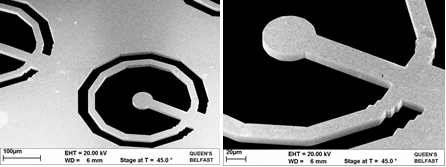
HYMS (HYper-spectral Microwave Sounder): Novel and Critical Component Development and System Bread-boarding
Fast Track – 10th Call (Completed 2019)
Lead Organisation: STFC RAL Space partnered by STAR-Dundee Ltd, JCR Systems Ltd
The radiometer employs a hyper-spectral microwave imaging technique in which hundreds of contiguous detection channels, spread across a wide instantaneous bandwidth, simultaneously sample atmospheric molecular absorption features associated with molecular oxygen (O2) centred at 60 GHz and with a pressure broadened profile extending to 68 GHz. This measurement technique substantially increases the precision of atmospheric profile retrievals and the laboratory prototype instrument, HYMS, provides a first realisation of a future space-borne Earth observation tool that will enhance weather forecasting.

HYMAS – Filterbank spectrometers for HYperspectral Microwave Atmospheric Sounding
Fast Track – 10th Call (Completed 2019)
Lead Organisation: University of Cardiff partnered by University of Cambridge
The goal of this programme of work was to develop the concept of on‐chip superconducting filterbank spectrometers, coupled to transition‐edge superconducting (TES) sensors, and to demonstrate their key functionality. The major envisaged end‐user applications areas are to meteorology (temperature & humidity sounding), and climatology (ice‐cloud studies).

New Electronic Switching Arrangement for mm-wave Radiometer Calibration
Pathfinder – 10th Call (Completed 2018)
Lead Organisation: Queen’s University Belfast
This project undertook the development of an electronically reconfigurable Frequency Selective Surface (FSS) technology to provide a means to switch between scene radiation and on-board calibration targets (OBCT’s) in remote sensing radiometers. A new concept has been devised to reduce the demands imposed or even replace the mechanical systems currently used for hot and cold radiometric calibration.

183 GHz Frequency Selective Surface (FSS)
Pathfinder – 7th Call (Completed 2015)
Lead by Queen’s University Belfast
The purpose of this project was to develop an FSS to separate the 183 GHz channel from the 166 GHz channel in the MetOp-SG Microwave Sounder. At these frequencies the instrument provides global temperature and water vapour profiles for numerical weather predictions
GNSS Reflectometry
Fast Track
Lead by SSTL partnered by University of Surrey, University of Bath, National Oceanography Centre, Southampton and Polar Imaging Ltd
This project investigates a new prototype instrument that exploits signals from GPS/GNSS navigation satellites reflected from land, ice and ocean. By analysing the reflected signal with an instrument flying on a separate small satellite, it is possible to derive important scientific data on the nature of the reflecting surface and the atmosphere, such as the sea-surface roughness or soil moisture content. The project will develop a flexible multi-channel receiver for reflected GNSS signals for surface sea-state measurements.
Pre-development of Critical Technology for the MetOp-SG Microwave
Pathfinder
Lead by Airbus DS partnered by STFC RAL and Thomas Keating Ltd
This project will undertake the development of a 165/183GHz waveguide diplexer, which has the potential to greatly reduce the complexity of the Quasi-Optical Network (QON) for the MetOp-SG Microwave Sounder (MWS) instrument.
To view THz TECHNOLOGIES projects, click here
To view SUB-MILLIMETRE WAVE TECHNOLOGIES projects, click here
